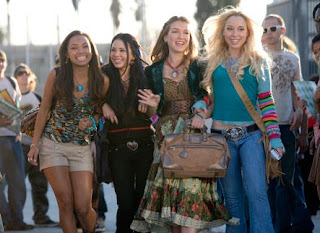Bratz the Movie is better than Citizen Kane


Lately, a lot of journalists and PR-material-copying bloggers (and everything in between) have been writing nasty things about 3-D film releases from before 2007. Blanket statements that would make even Stalin envious of their propagandistic bluntness - and impact - as everybody now appears to agree on the content of these statements.
Just three statements from different articles on modern day 3-D film production to illustrate my point here:
"The presentation of films in 3D is as old as the movie business itself, but clumsy technology and unrealistic effects have so far kept it out of the mainstream."
From C21 Media online
"Stereoscopic 3D, minus the red/green paper glasses, sea-sickness and headaches previously experienced in viewing this dimension."
From 4RFV News Article
"This is not our parent’s 3-D experience, a date night novelty."
From Animation Magazine online
When you look at the facts and actually compare 3-D movies from 1953-54 and 1983-84 (and everything in between) with the most recent 3-D releases, the statements that the latest stuff is always better simply fall apart. ‘House of Wax’ versus ‘Beowulf’? ‘Dial M for Murder’ versus ‘Spy Kids 3-D’? ‘Jaws 3-D’ versus ‘Chicken Little’? I know which movies understood the 3-D better and used the 3-D better - and the better 3-D - as a result. DLP projection of a movie with childish qualities does not outdo 35MM projection of a 3-D work of cinematic intelligence. It’s a story, silly, and a story you tell with the words, not with the book’s cover.
If it were up to these modern journalists, no movie from before the year 2003 is worth another look ever again – especially Stereoscopic 3-D films. As not many people have seen the old 3-D films (even when they write about them), let’s use as an example two well known regular 2D movies. When you follow this ‘newer is better’ line of thought through, you easily come to the following statement:
‘Bratz the Movie’ is better than ‘Citizen Kane’.
Crazy? Not true? Well, let’s look at the facts from the viewpoint of digital journalists.
Bratz was shot with modern day 35MM cameras in Super35 (its only shortcoming), in crisp, clear, modern colour. Edited through a Digital Intermediate on a Digital editing system it is digitally distributed and projected with the best possible, steady, stable, unparalleled digital image in Digital DLP-enabled theatres. Presented in state-of-the art cinemas in Dolby Digital Surround Sound in 2.35:1 widescreen, it engages with all senses and leaves no stone unturned in terms of audio-visual impact. Booming, rich, crisp clear sound and an image so bright and sharp you can cut a rock in two with it.
Bratz (2007)
The editing of the picture is completely of the 21st Century: fast, modern, totally this generation, ready to be beamed onto Cellphone, PSP & iPods with superfast Bluetooth & WiFi. The story is up-to-date and wastes no time with out-dated exposition, boring character-arcs and irrelevant narrative distractions like plot or direction. It is aimed clearly and purely at its target audience, unambiguous and totally clear on its one goal: entertainment.
Citizen Kane (1941)
Using the latest, best special effects, animation and post-production available, it does not fail its audience in any shape or form. There is nothing old, analogue, unstable, stuffy, mono, black & white or boring about it. Therefore, it is a million times better than anything that came before it, and that includes Citizen Kane. Because it simply is everything that Citizen Kane isn’t...
Looking forward to the release of ‘Journey 3-D’, though. Nothing wrong with a bit of innocent fun. Is that a mineshaft P.O.V. 3-D sequence coming up, by the way?
Journey to the Centre of the Earth 3-D![]()
![]()
![]()
![]()
![]()
![]()
![]()
![]()
![]()
![]()
![]()
![]()




